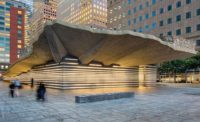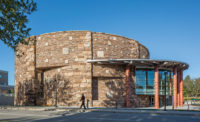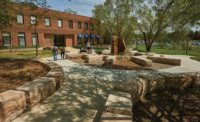With its striking spire constructed of Teakwood sandstone from India, the James Museum of Western and Wildlife Art stands prominently in downtown St. Petersburg, FL. The beautiful color gradation of the stone, coupled with the complex angles of the design, are a formula for an artistic and elegant building aesthetic that will inspire visitors and passersby alike. As the saying goes, “It takes a village.” And that is exactly what was needed to erect this 84,000-square-foot cultural facility, which included a total of 4,406 unique stone panels – 2, 3 and 5cm thick — with heights of 18, 24 and 30 inches. The finished project is the result of a dedicated team of industry professionals who worked tirelessly as a united force to ensure a successful stone installation. The St. Pete Design Group, a joint-venture between Wannemacher Jensen Architects, Harvard Jolly Architecture and Yann Weymouth, was responsible for the museum’s stunning design.
“It’s an interesting job,” said Jim DeLoach, CEO of ASI Stone Imports, Inc. in Chelsea, AL, who supplied the stone for the project. “It’s like a piece of art.”
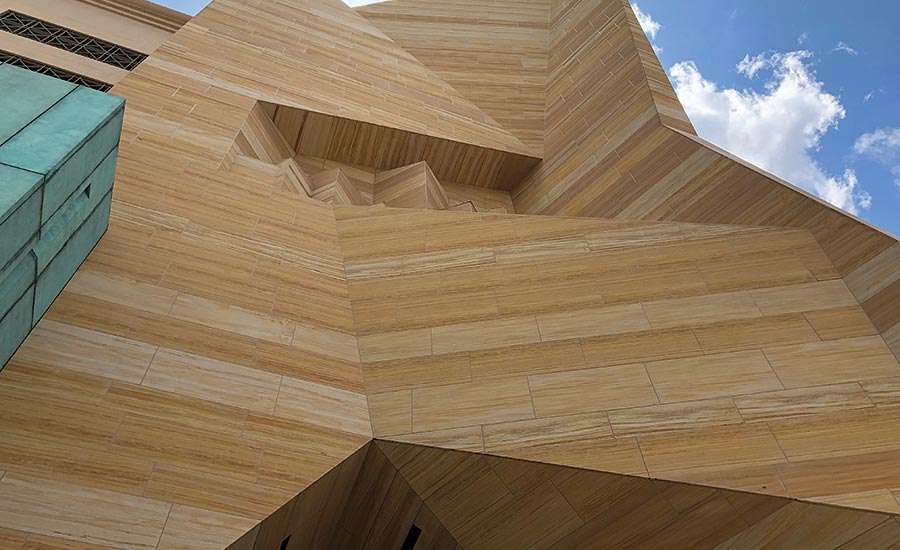
The majority of the James Collection is focused on the art of the American West, and clients Tom and Mary James and their design team wanted a building that would evoke the experience of the Southwest. They wanted a stone evoking the colors and striation of the canyons and ravines of Nevada, Arizona and Utah to create the exterior 110-foot-high “Mesa” that forms the entry and the interior sculpture hall, the “Arroyo.”
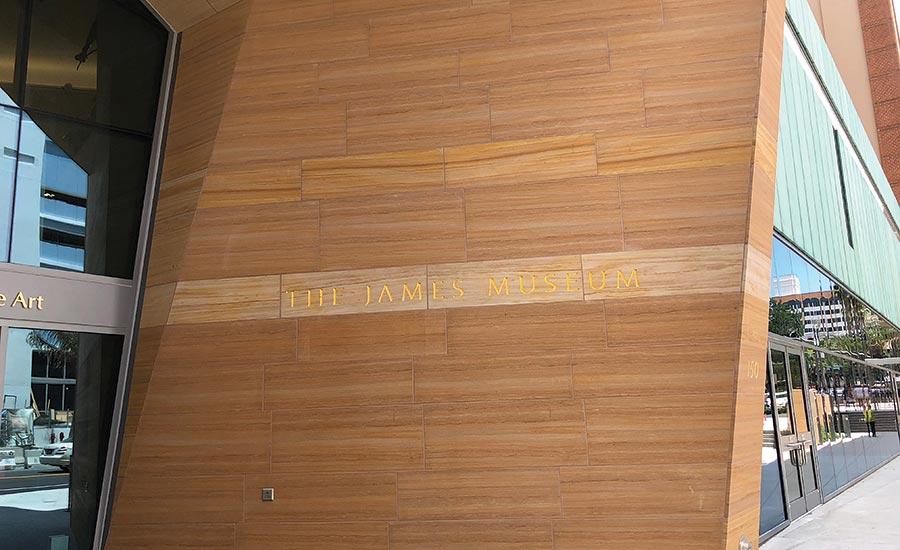
After exhausting the possibilities to find an American western stone for the project, the St. Pete Design Group and construction manager Beck Group contacted DeLoach to help find the right material. ASI turned to Tab India, which has a U.S. operation, Amsum & Ash, in Minneapolis, MN, as a source for the material. “They came to us and said they wanted sandstone,” he said. “We started submitting what we thought would work for them. Tab was extremely cooperative.” After reviewing various sandstone varieties, it was soon decided that Tab’s Teakwood sandstone from near Jaipur would be the appropriate choice for the museum’s unique exterior design, as well as its interior public spaces.
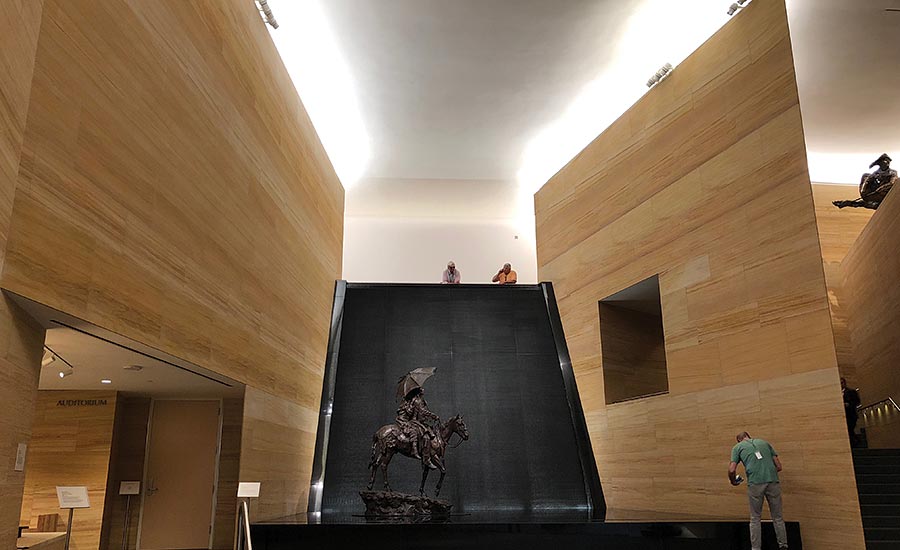
“The Beck Group, who was the general contractor, came to us and asked if we could put together the job,” explained DeLoach. “We used to have a huge installation group, but we only furnish stone now. I said we could do that, but we have to bring someone else in to do the install; so, we brought in Intrepid [Enterprises Inc.] to manage and perform the installation.
“We then got Tab involved,” DeLoach went on to say. “We had done quite a few jobs with Tab before and are very familiar and comfortable with their team. We also knew their superintendent who runs the shop in India. The shop drawings and angles were a challenge. We had to figure out how to make the pieces fit. Almost every piece was an angle. It was difficult, but we had a good team.”
Determining a color range
According to DeLoach, Moses Henry performs quality control for ASI in India. A team, consisting of the owner, the architects, Kevin Becnel, Intrepid’s senior project manager, and Henry, was assembled to visit Tab’s factory in India. The group of experts in their respected fields had to agree on a color range. “They wanted three different shades – light, dark and medium,” explained DeLoach.
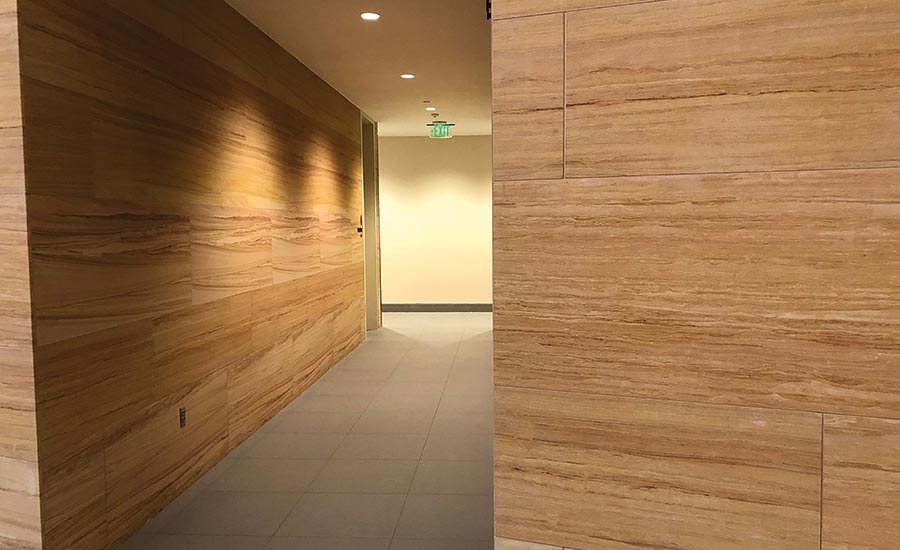
When in India, the team relied on the guidance of Ravi Sharma from Tab India and Henry during the selection process. “When the team visited India, they had so many questions in mind regarding the material striations, hue, shades — like light, medium and dark — so we showed them two mock-ups that clarified their questions very well,” explained Sharma. “The stone had an overall good presentation. We showed them our stockyard so they could easily understand the nature of the stone. The visit helped make a good understanding between all of us.”
According to Sharma, the first task was to pre-lay the pieces as per the tickets and drawings that ASI provided to Tab India. “We cut the material, having matched the veins and shades within the blocks to ensure the overall look,” he said. “The material was soft to dry lay and there was a chance that the pieces could break, so we had to be very careful to place and lift the pieces. We checked so many things such as vein matching, shade matching, surface finishing and the perfection of the fabrication work.
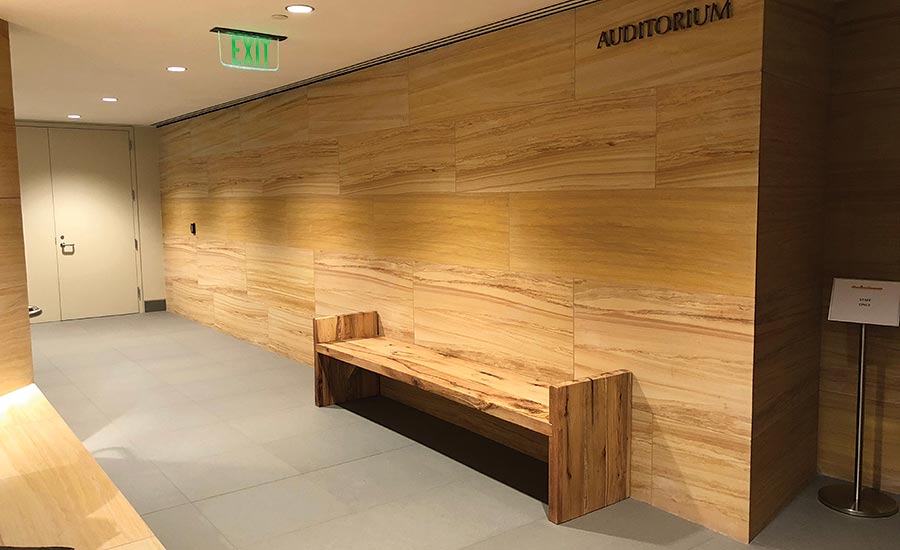
“We had to cut every piece of a row from the same block, so we had to prepare every block on paper before cutting every row’s pieces,” continued Sharma. “We did preparation before processing the material. The pre-planning helped us a lot to execute the task. The building layout and design had so many 3D effects, so it was a very crucial part to get the things done with perfection. We matched every piece of stone in each row — every piece’s shade in each row. We had done the angle cutting and fabrication work very carefully and with perfection.”
Once the group agreed on the color range, they had to see how it played out into the facade and the interior design, explained DeLoach. “Once they got that done, we entered into production,” he said. “Every shipment, every elevation, had to be pre-laid, which Tab did along with our guy, Moses Henry. He worked along with Ravi, who was a very big part of the project and a cooperative guy.”
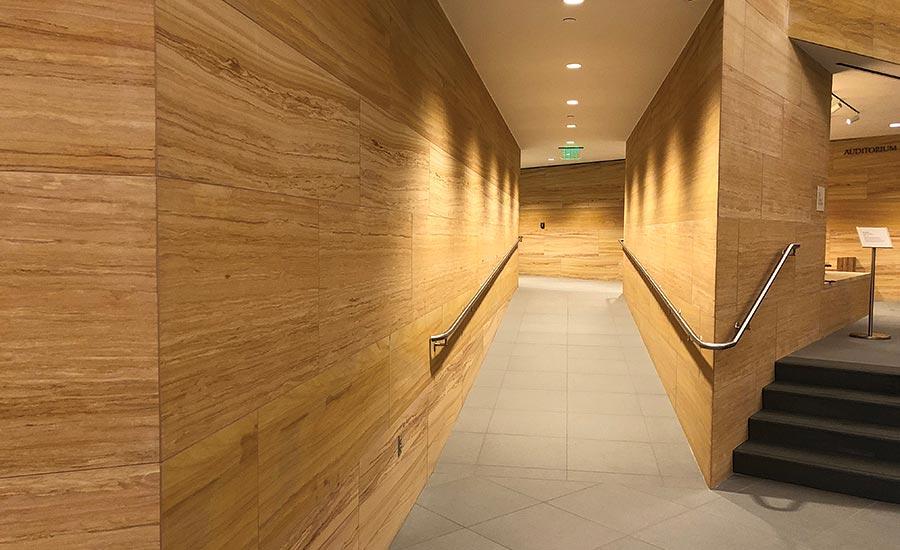
To ensure that each band of stone was appropriately matched in veining and color, architects Sonavadekur, Weymouth and Everald Colas in the U.S. worked closely with Tab to review before approval of every stone in each pre-lay. “It took over several days to get a container approved,” Deloach went on to say. “I was sending and receiving pictures. Sometimes we would push back and tell them they had to accept [the stone] because it fell within the range. The stone was shipped from India to Tampa. That went on for eight to 10 months.”
A complicated installation
“This wasn’t really that big of a project, but it was perhaps the most complex installation we have ever done,” said Harold Prestenburg, CEO of Intrepid. “There were so many odd shapes. Typically, a building is square or rectangular. Here, there were all these points in the sky. It was a very difficult layout situation.”
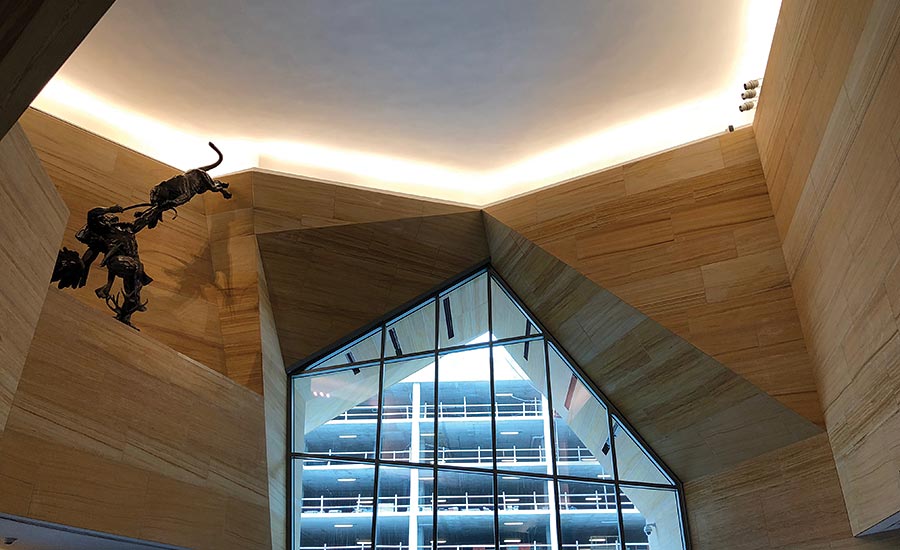
As the senior project manager, Becnel worked closely with all those involved to keep the project running smoothly. “From the get-go, we knew what they were looking for,” he said. “It was a matter of establishing the range. We looked at many different blocks and pre-cut slabs [on our trip to the factory] – establishing the light, medium and dark range. It helped to establish distinctive layers.”
Becnel went on to explain that the layout of the exterior spire posed a challenge. “The spire itself took almost five months to install,” he said. “There were lots of hurdles with the structure. We would find it was leaning one way or another and then we would have to make adjustments. We spent time trying to determine what we could do to make it work. Our superintendent, Howard Franklin, and foreman, Charlie Peterson, really made it a successful installation.”
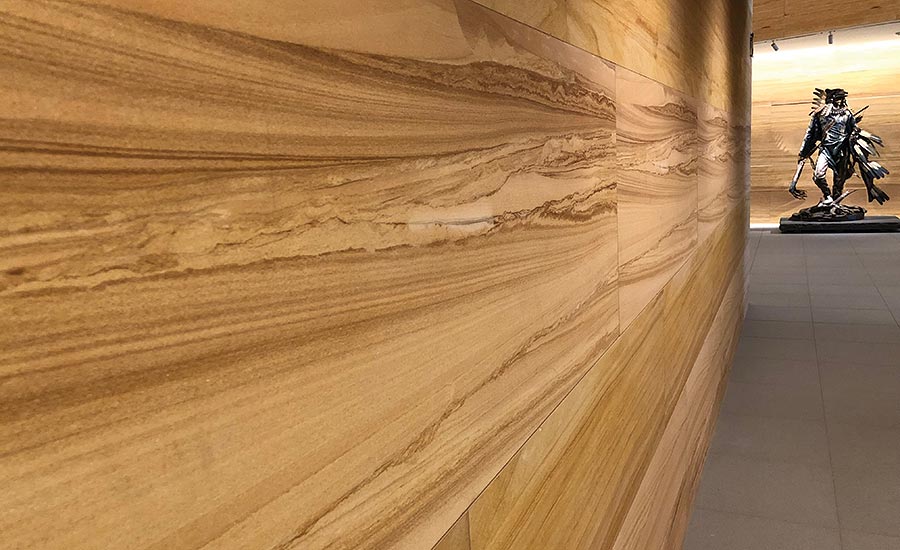
At one time, there were 20 members of the install crew on the jobsite. “We couldn’t use more because of the complexity,” said Becnel. “We had distributing crews taking pieces out of the crates, and we had to hoist every piece individually to the scaffold.”
Each sandstone piece was individually numbered for location in order to ensure veining and color continuity in each band of stone. The pieces were mechanically attached to a steel substructure with aluminum anchors. Both Becnel and Prestenburg said architect Yann Weymouth would visit the site daily to observe and discuss the installation with Franklin.
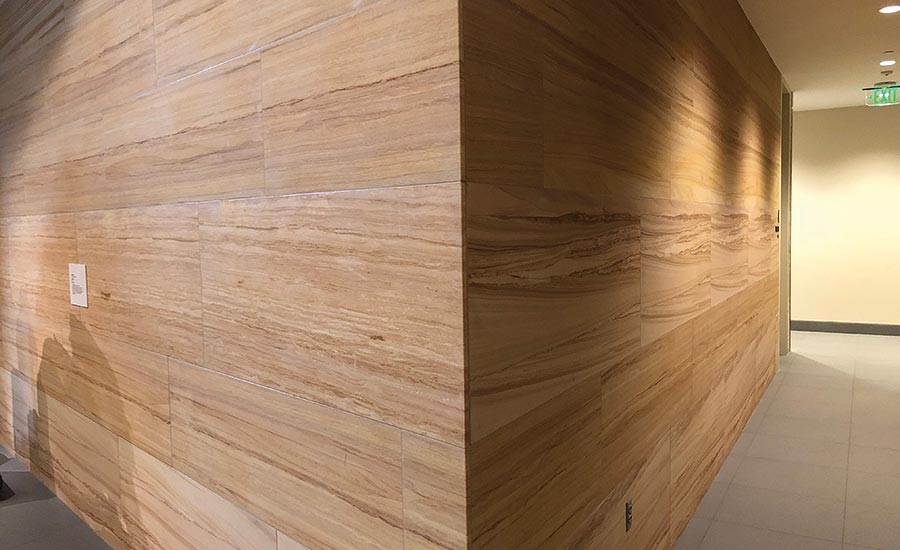
An additional five months were required to install the interior stonework. After the project’s completion, Prestenburg has had time to reflect on it. “It went slower than anticipated,” he said. We did not have experience with this complex design before so we didn’t know what the production rate would be.”
DeLoach was pleased with the finished results. “They carried it out and did a great job — making a big hit with the architects,” he said. “Some jobs you take a liking to and this was one of them. This one got my attention.”
The architecture of the museum and particularly the sandstone of the Mesa entry and Arroyo entry hall have generated significant interest and visitor attendance, highlighting and contributing to the power of the art collection.
|
James Museum of Western and Wildlife Art St. Petersburg, FLOwners: Tom and Mary James, St. Petersburg, FL |


